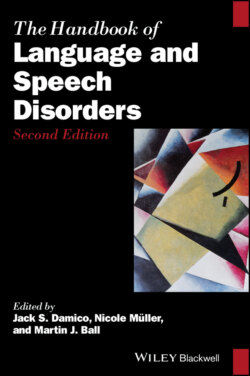Читать книгу The Handbook of Language and Speech Disorders - Группа авторов - Страница 47
3.3.3 Recognition of Segments
ОглавлениеOn an acoustic surface level, the speech signal can be divided into three dimensions: spectral (determined by frequency content), temporal, and amplitude (intensity). As discussed previously, pitch perception and perceptual judgments in the frequency domain are particularly difficult for CI listeners, which is in large part due to the electrical–neuronal bottleneck. The bottleneck helps in understanding CI users’ speech perception deficits and receptive communication abilities. As a general observation, many implanted children and adults are able to reach a functional level of speech understanding as well as intelligibility, although speech perceptual studies of CI listeners are notorious for showing a large degree of variation in the results. However, besides the fact that this success testifies to the robustness of speech and language perception and production, it belies their deficits in the perception of subtle levels of speech phenomena that are immediately perceptible to normally hearing listeners.
A recent review of consonant and vowel perception in children and adults with CIs as measured with nonsense word tests, performed by 581 postlingually deafened and 66 prelingually deafened participants in the course of 50 studies, noted that CI users have more difficulty with the identification of vowels and consonants than NH controls, who tend to perform at or near ceiling level (Rødvik, von Koss Torkildsen, Wie, Storaker, & Silvola, 2018). The postlingually deafened participants had a mean score of 76.8% on vowel identification and 58.4% on consonant identification, whereas this was 67.7 and 47.7%, respectively, for the prelingually deafened subjects. The differences between the two groups was, however, not significant. Vowels and consonants that are most often confused are those that have the same articulation manner and/or duration and voicing but different places of articulation, such as the consonants /p, t, k/ or /m, n/ and the vowels /&ip.iscp;, ɛ, ʌ, ʊ/.
This review shows that CI users have more trouble identifying consonants than vowels. The authors attributed this to the fact that vowels have a longer duration and higher acoustic energy than consonants. It also shows that segmental confusions tend to occur between sounds that share spectral properties. This makes sense given what we know about the electrical–neuronal perceptual bottleneck that is a part of CI listening, and the difficulty that this incurs for the perception of contrasts that are cued by changes in the frequency dimension. The authors furthermore noted that the advantage of using nonsense words over real words is that they circumvent the influence of the lexicon, which would obscure purely phonetic perceptual abilities. Moreover, the usage of nonsense words, which is more challenging than tests for recognition of real words, has a higher chance of avoiding performance at ceiling and is therefore a more sensitive alternative as a test for assessing speech perception abilities by CI users. These are, of course, valid arguments for using nonsense word tests in experimental contexts, but in terms of rehabilitation, the ultimate goal of which is to improve real‐world speech perceptual ability, nonsense words may not be the optimal choice of speech material for the obvious reason that CI recipients would be being trained on words that do not exist.
